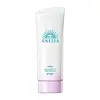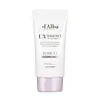What's inside
What's inside
 Key Ingredients
Key Ingredients

 Benefits
Benefits

 Concerns
Concerns

 Ingredients Side-by-side
Ingredients Side-by-side

Water
Skin ConditioningDimethicone
EmollientEthylhexyl Methoxycinnamate
UV AbsorberAlcohol
AntimicrobialZinc Oxide
Cosmetic ColorantTitanium Dioxide
Cosmetic ColorantGlycerin
HumectantDiisopropyl Sebacate
EmollientTranexamic Acid
AstringentDiphenylsiloxy Phenyl Trimethicone
Skin ConditioningDiethylamino Hydroxybenzoyl Hexyl Benzoate
UV FilterPEG-100 Hydrogenated Castor Oil
EmulsifyingPEG-60 Hydrogenated Castor Oil
EmulsifyingSilica
AbrasivePPG-17
Skin ConditioningHydrated Silica
AbrasiveIsostearic Acid
CleansingBis-Ethylhexyloxyphenol Methoxyphenyl Triazine
Skin ConditioningDimethylacrylamide/Sodium Acryloyldimethyltaurate Crosspolymer
CI 77891
Cosmetic ColorantAluminum Hydroxide
EmollientPhenoxyethanol
PreservativeEthylhexyl Triazone
UV AbsorberDextrin Palmitate
EmulsifyingHydrogen Dimethicone
Mica
Cosmetic ColorantSorbitan Sesquiisostearate
EmulsifyingBeheneth-20
EmulsifyingSuccinoglycan
Skin ConditioningCellulose Gum
Emulsion StabilisingParfum
MaskingBHT
AntioxidantTocopherol
AntioxidantCitric Acid
BufferingSodium Metaphosphate
BufferingTrisodium EDTA
Dipotassium Glycyrrhizate
HumectantHydroxypropyl Methylcellulose Stearoxy Ether
Sodium Citrate
BufferingButylene Glycol
HumectantTalc
AbrasiveSodium Metabisulfite
AntioxidantPEG/PPG-14/7 Dimethyl Ether
Skin ConditioningCI 17200
Cosmetic ColorantCamellia Sinensis Leaf Extract
AntimicrobialPotentilla Erecta Root Extract
Skin ConditioningCI 42090
Cosmetic ColorantSodium Acetylated Hyaluronate
HumectantPolyquaternium-51
Skin ConditioningSoluble Collagen
HumectantWater, Dimethicone, Ethylhexyl Methoxycinnamate, Alcohol, Zinc Oxide, Titanium Dioxide, Glycerin, Diisopropyl Sebacate, Tranexamic Acid, Diphenylsiloxy Phenyl Trimethicone, Diethylamino Hydroxybenzoyl Hexyl Benzoate, PEG-100 Hydrogenated Castor Oil, PEG-60 Hydrogenated Castor Oil, Silica, PPG-17, Hydrated Silica, Isostearic Acid, Bis-Ethylhexyloxyphenol Methoxyphenyl Triazine, Dimethylacrylamide/Sodium Acryloyldimethyltaurate Crosspolymer, CI 77891, Aluminum Hydroxide, Phenoxyethanol, Ethylhexyl Triazone, Dextrin Palmitate, Hydrogen Dimethicone, Mica, Sorbitan Sesquiisostearate, Beheneth-20, Succinoglycan, Cellulose Gum, Parfum, BHT, Tocopherol, Citric Acid, Sodium Metaphosphate, Trisodium EDTA, Dipotassium Glycyrrhizate, Hydroxypropyl Methylcellulose Stearoxy Ether, Sodium Citrate, Butylene Glycol, Talc, Sodium Metabisulfite, PEG/PPG-14/7 Dimethyl Ether, CI 17200, Camellia Sinensis Leaf Extract, Potentilla Erecta Root Extract, CI 42090, Sodium Acetylated Hyaluronate, Polyquaternium-51, Soluble Collagen
Water
Skin ConditioningPropanediol
SolventButyloctyl Salicylate
Skin ConditioningTitanium Dioxide
Cosmetic ColorantDibutyl Adipate
EmollientDicaprylyl Carbonate
EmollientDiethylamino Hydroxybenzoyl Hexyl Benzoate
UV FilterPolysilicone-15
UV FilterNiacinamide
SmoothingDiisopropyl Sebacate
EmollientDiphenylsiloxy Phenyl Trimethicone
Skin Conditioning2,3-Butanediol
HumectantEthylhexyl Triazone
UV Absorber1,2-Hexanediol
Skin ConditioningPentylene Glycol
Skin ConditioningTuber Magnatum Extract
Skin ConditioningTocopherol
AntioxidantCoccinia Indica Fruit Extract
Skin ConditioningEclipta Prostrata Extract
Skin ConditioningStellaria Media Extract
Skin ConditioningPortulaca Oleracea Extract
Skin ConditioningHouttuynia Cordata Extract
Skin ConditioningLavandula Angustifolia Flower Extract
CleansingAdansonia Digitata Leaf Extract
Skin ConditioningCentella Asiatica Extract
CleansingBuddleja Davidii Extract
Skin ConditioningOlea Europaea Leaf Extract
PerfumingThymus Vulgaris Extract
PerfumingCitrus Aurantium Dulcis Oil
MaskingSimmondsia Chinensis Seed Oil
EmollientCitrus Nobilis Peel Oil
MaskingLitsea Cubeba Fruit Oil
MaskingSalvia Officinalis Leaf Water
MaskingCentaurea Cyanus Flower Water
Skin ConditioningButylene Glycol
HumectantPolymethylsilsesquioxane
Coco-Caprylate/Caprate
EmollientMethylpropanediol
SolventVp/Eicosene Copolymer
Polyglyceryl-2 Caprate
EmulsifyingGlycerin
HumectantPolyhydroxystearic Acid
EmulsifyingSucrose Stearate
EmollientAmmonium Acryloyldimethyltaurate/Vp Copolymer
Polyacrylate Crosspolymer-6
Emulsion StabilisingInulin Lauryl Carbamate
Emulsion StabilisingHydroxypropyl Methylcellulose Stearoxy Ether
Stearic Acid
CleansingEthylhexylglycerin
Skin ConditioningAlumina
AbrasiveGlyceryl Caprylate
EmollientAluminum Hydroxide
EmollientTriethoxycaprylylsilane
Xanthan Gum
EmulsifyingAdenosine
Skin ConditioningSqualane
EmollientPolyether-1
Lactobacillus Ferment
Skin ConditioningGlutathione
Allantoin
Skin ConditioningPanthenol
Skin ConditioningCaesalpinia Spinosa Gum
Skin ConditioningBiosaccharide Gum-1
HumectantHydrolyzed Hyaluronic Acid
HumectantMaltodextrin
AbsorbentWine
Skin ConditioningUltramarines
Limonene
PerfumingWater, Propanediol, Butyloctyl Salicylate, Titanium Dioxide, Dibutyl Adipate, Dicaprylyl Carbonate, Diethylamino Hydroxybenzoyl Hexyl Benzoate, Polysilicone-15, Niacinamide, Diisopropyl Sebacate, Diphenylsiloxy Phenyl Trimethicone, 2,3-Butanediol, Ethylhexyl Triazone, 1,2-Hexanediol, Pentylene Glycol, Tuber Magnatum Extract, Tocopherol, Coccinia Indica Fruit Extract, Eclipta Prostrata Extract, Stellaria Media Extract, Portulaca Oleracea Extract, Houttuynia Cordata Extract, Lavandula Angustifolia Flower Extract, Adansonia Digitata Leaf Extract, Centella Asiatica Extract, Buddleja Davidii Extract, Olea Europaea Leaf Extract, Thymus Vulgaris Extract, Citrus Aurantium Dulcis Oil, Simmondsia Chinensis Seed Oil, Citrus Nobilis Peel Oil, Litsea Cubeba Fruit Oil, Salvia Officinalis Leaf Water, Centaurea Cyanus Flower Water, Butylene Glycol, Polymethylsilsesquioxane, Coco-Caprylate/Caprate, Methylpropanediol, Vp/Eicosene Copolymer, Polyglyceryl-2 Caprate, Glycerin, Polyhydroxystearic Acid, Sucrose Stearate, Ammonium Acryloyldimethyltaurate/Vp Copolymer, Polyacrylate Crosspolymer-6, Inulin Lauryl Carbamate, Hydroxypropyl Methylcellulose Stearoxy Ether, Stearic Acid, Ethylhexylglycerin, Alumina, Glyceryl Caprylate, Aluminum Hydroxide, Triethoxycaprylylsilane, Xanthan Gum, Adenosine, Squalane, Polyether-1, Lactobacillus Ferment, Glutathione, Allantoin, Panthenol, Caesalpinia Spinosa Gum, Biosaccharide Gum-1, Hydrolyzed Hyaluronic Acid, Maltodextrin, Wine, Ultramarines, Limonene
 Reviews
Reviews

Ingredients Explained
These ingredients are found in both products.
Ingredients higher up in an ingredient list are typically present in a larger amount.
Aluminum Hydroxide is a form of aluminum. It can be naturally found in nature as the mineral gibbsite. In cosmetics, Aluminum Hydroxide is used as a colorant, pH adjuster, and absorbent.
As a colorant, Aluminum Hydroxide may add opacity, or reduce the transparency. Aluminum hydroxide is contains both basic and acidic properties.
According to manufacturers, this ingredient is an emollient and humectant. This means it helps hydrate the skin.
In medicine, this ingredient is used to help relieve heartburn and help heal ulcers.
There is currently no credible scientific evidence linking aluminum hydroxide in cosmetics to increased cancer risk.
Major health organizations allow the use of aluminum hydroxide in personal care products and have not flagged it as a carcinogenic risk at typical usage levels.
Learn more about Aluminum HydroxideButylene Glycol (or BG) is used within cosmetic products for a few different reasons:
Overall, Butylene Glycol is a safe and well-rounded ingredient that works well with other ingredients.
Though this ingredient works well with most skin types, some people with sensitive skin may experience a reaction such as allergic rashes, closed comedones, or itchiness.
Learn more about Butylene GlycolDiethylamino Hydroxybenzoyl Hexyl Benzoate (DHHB) is a chemical UV-A absorber. It is formulated for high UVA protection (320-400 nm).
DHHB is well-liked for:
DHHB has been approved by the EU, Japan, Taiwan, and South America for use up to 10%. Unfortunately, it has not been approved for use in the US or Canada due to slow regulatory processes.
This ingredient is soluble in oils, fats, and lipids.
Learn more about Diethylamino Hydroxybenzoyl Hexyl BenzoateWe don't have a description for Diisopropyl Sebacate yet.
Diphenylsiloxy Phenyl Trimethicone is a silicone. It has a high refractive index and adds shine to formulations.
According to the safety review by the Cosmetic Ingredient Review (CIR) Expert Panel, it is safe for use in cosmetics under the current practices and concentrations.
Ethylhexyl Triazone is a modern chemical sunscreen that protects from UV-B radiation.
It is the most effective of existing UV-B filters, as it provides the highest level of photo-stable absorption. It protects from the entire UV-B range (280 to 320nm), with it's highest level of protection at 314nm.
Ethylhexyl Triazone is oil soluble, oderless and colorless, which mean it is able to be incorporated into a variety of different formulations.
It is not currently available within the United States due to slow changing FDA regulations. Outside of the US, it is used in formulations at concentrations up to 5%.
Learn more about Ethylhexyl TriazoneGlycerin is already naturally found in your skin. It helps moisturize and protect your skin.
A study from 2016 found glycerin to be more effective as a humectant than AHAs and hyaluronic acid.
As a humectant, it helps the skin stay hydrated by pulling moisture to your skin. The low molecular weight of glycerin allows it to pull moisture into the deeper layers of your skin.
Hydrated skin improves your skin barrier; Your skin barrier helps protect against irritants and bacteria.
Glycerin has also been found to have antimicrobial and antiviral properties. Due to these properties, glycerin is often used in wound and burn treatments.
In cosmetics, glycerin is usually derived from plants such as soybean or palm. However, it can also be sourced from animals, such as tallow or animal fat.
This ingredient is organic, colorless, odorless, and non-toxic.
Glycerin is the name for this ingredient in American English. British English uses Glycerol/Glycerine.
Learn more about GlycerinWe don't have a description for Hydroxypropyl Methylcellulose Stearoxy Ether yet.
Titanium dioxide is a mineral UV filter widely used in sunscreens and cosmetics.
It is one of only two UV filters officially classified as “mineral” by regulatory agencies, the other being zinc oxide.
Titanium dioxide provides broad-spectrum protection mostly in the UVB and UVAII range, with some protection in the UVAI range.
While its UVA protection isn’t as strong as zinc oxide’s, the difference is minor.
A common myth is that mineral UV filters reflect UV light. However, modern research shows titanium dioxide absorbs UV radiation like chemical filters (~95% absorption & 5% reflection).
Thanks to its non-irritating nature, titanium dioxide is suitable for sensitive, acne-prone, or redness-prone skin. It is unlikely to cause "eye sting" like other sunscreen ingredients.
A major drawback of this ingredient is its white cast and thick texture. This is why mineral sunscreens often leave a white cast and are less cosmetically elegant than chemical/hybrid sunscreens.
To improve white cast and spreadability, micronized or nano-sized titanium dioxide is often used.
There are ongoing concerns surrounding nano-titanium oxide's impact on marine ecosystems.
There is no conclusive evidence that any form of titanium oxide (or any other sunscreen ingredients) will cause harm to marine ecosystems or coral reefs. The science is still developing but many consumers are keeping a close eye on this issue.
Please note, many destinations have reef-safety sunscreen rules. For instance, the U.S. Virgin Islands advises all visitors to use non-nano mineral sunscreens.
Nano mineral sunscreens once raised safety concerns about absorption into skin.
Extensive research has shown that they do not penetrate healthy or damaged skin; they remain safely on the surface and the top layer of dead skin (stratum corneum).
You'll likely find titanium dioxide bundled with alumina, silica, or dimethicone. These ingredients help make titanium dioxide highly photostable; this prevents it from interacting with other formula components under UV light.
Learn more about Titanium DioxideTocopherol (also known as Vitamin E) is a common antioxidant used to help protect the skin from free-radicals and strengthen the skin barrier. It's also fat soluble - this means our skin is great at absorbing it.
Vitamin E also helps keep your natural skin lipids healthy. Your lipid skin barrier naturally consists of lipids, ceramides, and fatty acids. Vitamin E offers extra protection for your skin’s lipid barrier, keeping your skin healthy and nourished.
Another benefit is a bit of UV protection. Vitamin E helps reduce the damage caused by UVB rays. (It should not replace your sunscreen). Combining it with Vitamin C can decrease sunburned cells and hyperpigmentation after UV exposure.
You might have noticed Vitamin E + C often paired together. This is because it is great at stabilizing Vitamin C. Using the two together helps increase the effectiveness of both ingredients.
There are often claims that Vitamin E can reduce/prevent scarring, but these claims haven't been confirmed by scientific research.
Learn more about TocopherolWater. It's the most common cosmetic ingredient of all. You'll usually see it at the top of ingredient lists, meaning that it makes up the largest part of the product.
So why is it so popular? Water most often acts as a solvent - this means that it helps dissolve other ingredients into the formulation.
You'll also recognize water as that liquid we all need to stay alive. If you see this, drink a glass of water. Stay hydrated!
Learn more about Water